
Two Great Flower Shows: A Comparison

Contributor

Floral exhibitions and garden shows have long been a traditional outlet for growers to showcase their finest plants and superb flowers, all to be scrutinized by seasoned professional horticulturists and admired by the general public. The symbolism of flowers and the emotions they elicit are universal, as is the connection to nature that we find in a garden. In some countries, particularly England, gardening is both a national pastime and a highly respected vocation. In the United States, gardening has a lower status, often associated with menial labor and non-essential, post-retirement or leisure-time endeavors. I’ve been involved with Seattle’s Northwest Flower & Garden Show for some time, but 2011 found me attending the Chelsea Flower Show in London for the first time. It was fascinating to compare the two events in light of these national distinctions.
Since 1862, when it was opened as the Great Spring Show, the Chelsea Flower Show has been the epitome of horticultural display, regularly generating tremendous interest and attracting loyal visitors from around the globe. Touted as the “world’s greatest flower show,” Chelsea remains a grand showcase for the United Kingdom’s national pastime. Held at the end of May, this remarkable extravaganza sets the standard for a floral exhibition.
The Pacific Northwest has its own version of Chelsea: the Northwest Flower and Garden Show (NWFGS). With less grandeur and publicity, it is held in February (when almost nothing is in bloom outdoors) and draws an enthusiastic audience who stroll comfortably indoors to experience a completely different season. Launched in 1989, it has become the largest exhibition of its kind on the West Coast and the second largest flower show in the United States.
London and Seattle share a similar climate, plant palette, and a thriving horticultural scene, yet the approach to exhibition is strikingly different at these two venues. This article aims to compare the two shows, by examining the venues, publicity, plants and design, and the presence of youth (the next generation of gardeners)—the latter a topic of great interest to me.
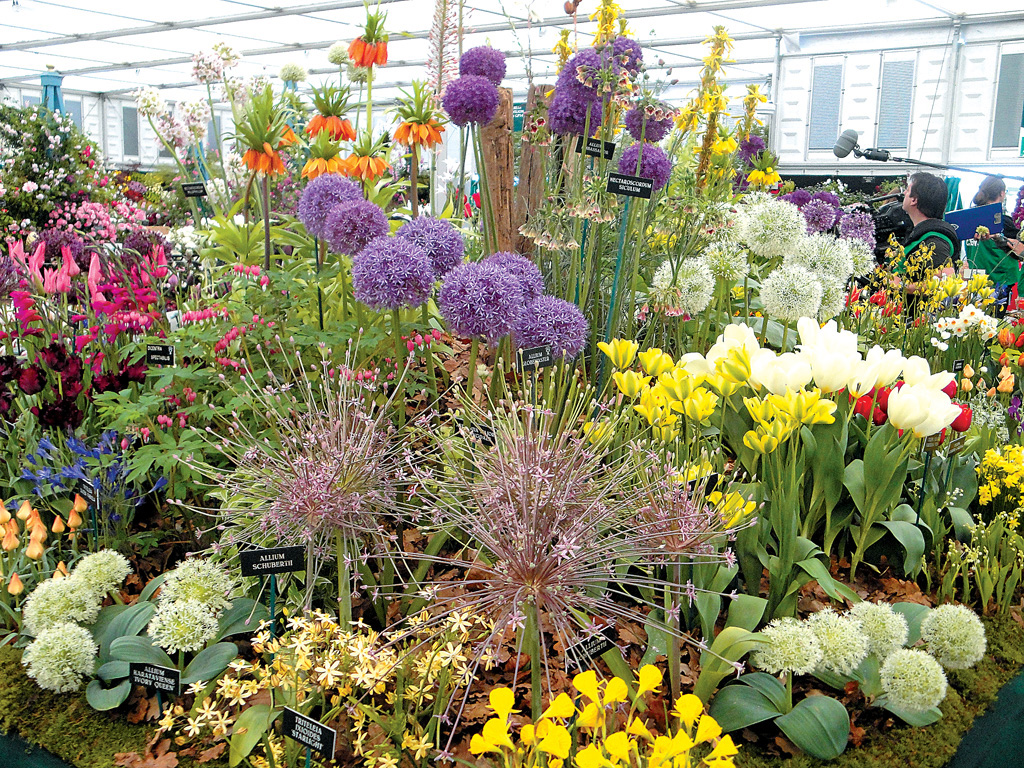
Different Venues, Different Seasons
Chelsea takes place on eleven acres of the Royal Hospital grounds, and comprises outdoor show gardens and the central grand marquee—a three-acre tent sheltering horticultural displays that range from tender tropical plants, flown in from places like Barbados or Trinidad, to alpine plants grown in cool conservatories. There are also areas for vendors offering art and garden-related products.
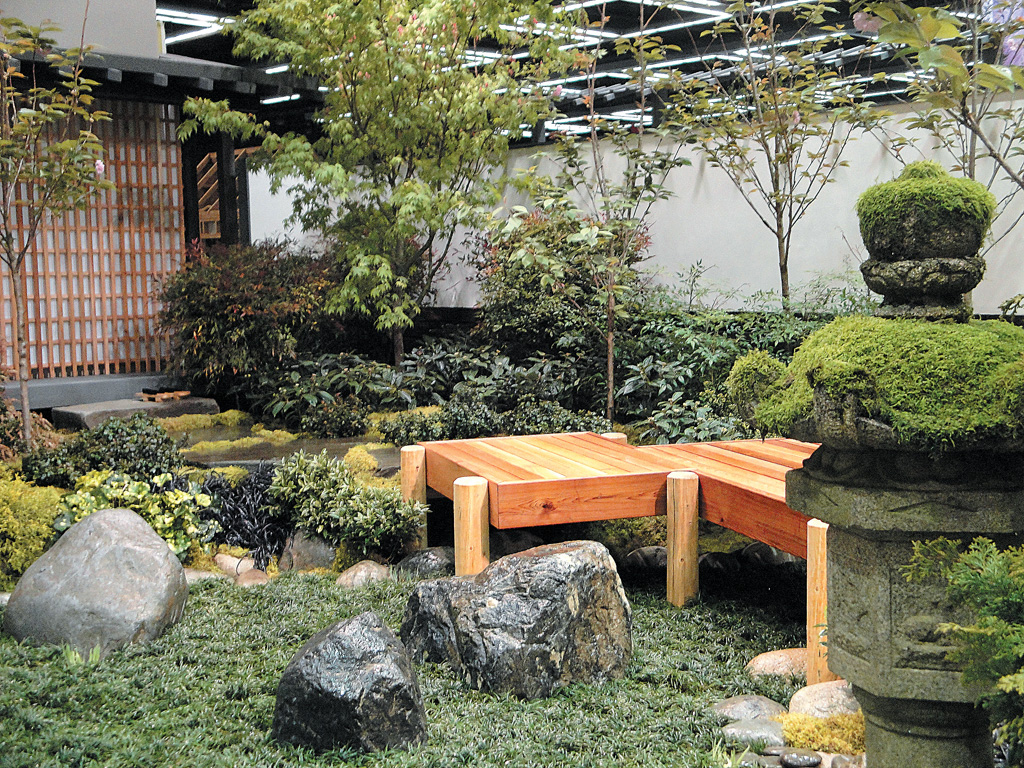
The NWFGS fills six acres of floor space and lecture halls in the exhibition halls of the Washington State Convention and Trade Center in downtown Seattle. In addition to display gardens, a large marketplace is filled with booths offering plants and garden accoutrements. Room is also allotted to nonprofit organizations related to plant collecting, gardening, education, and the environment.
What makes the two shows distinct is the season in which they are held. Clearly, it is easier to coddle into bloom a broad range of plants for a flower show in May than for a winter exhibition, where plants have to be forced or kept under cover so they look their absolute best once the show starts. The NWFGS capitalizes on grand floral displays to attract an audience when most gardens are dormant under cool, gray skies; jaws drop and heads turn upon seeing hybrid tea roses and oriental lilies in full bloom in February.
The More Press, the Better
The amount of press coverage and publicity generated by the Chelsea Flower Show was overwhelming and clearly an indication of how popular this show is. When I landed at Heathrow and was asked the purpose of my visit, I proudly stated that I was there for Chelsea; the officer’s face lit up. “Ah, splendid! I’ve not been myself, but it should be incredible as always. Enjoy yourself, chap!”
Almost everywhere in London were advertisements for the show, underwritten by the M & G Group, an investment firm that has sponsored the show for two years. On city buses, in subway stations, and in department store windows, it was impossible to miss the show. Television coverage by the BBC, each night of the show, was extensive and exciting, well beyond anything seen in Seattle.
With the rise of social media, both shows have taken advantage of an ever-broadening network of garden lovers and have made great strides in making the show more accessible to visitors. A mobile phone app was unveiled for Chelsea attendees this year. The NWFGS sends out regular show updates and events via Facebook and Twitter throughout the year.
I was fortunate to attend the Chelsea Flower Show during press day and to witness something we just don’t see in the United States: the glorification of plants and the big names that promote them. Tickets for the preview gala at Chelsea sell out in a matter of hours. Traditionally, Chelsea marks the start of the English social season, and to be seen at the show in elaborate frock or high-end fashion is the goal of many. Soon after the first flight of press are allowed into the show grounds, models can be seen posing and strutting in show gardens, with flagstone pavers or masses of creeping thyme as their catwalk. A press handout lists the names of famous celebrities that would be making an appearance. Such legendary performing artists and actors as Ringo Starr, Gwyneth Paltrow, Helen Mirren, and Vanessa Redgrave were in attendance at last year’s gala. The stars come out to see and be seen, often to “launch” new plant introductions that will bear their name. Should any of them fancy a particular plant or display amongst the hundreds of exhibitors, the resulting exposure can be worth countless advertising pounds for an exhibitor.
Press day at the Northwest Flower and Garden Show bears little resemblance to that encountered in London. While the show attracts big names in landscape design and horticulture from around the world, the biggest celebrity to make an appearance is likely to be a local radio or television personality who is actually a member of the press getting a sneak peak at the gardens. The preview gala for the show is a fundraiser for the Arboretum Foundation. While attendance and funds raised for the Arboretum have been steady, the presence of a major celebrity might boost ticket sales and revenue. In England, horticulturists are known, respected, and even celebrated. In the Pacific Northwest, only a handful of regular columnists, garden writers, and communicators might be recognized, and then only by a small percentage of the population.
I dream of the day when the Northwest’s major corporations (Starbucks, Google, Amazon, Microsoft) take an interest in the garden show. Imagine the convention center flanked by media as well-known software CEOs stroll the show gardens or a popular Grammy award-winning musician savors the scent of a Chinese witch hazel. Moments such as these would suggest to the larger community that this show is worth visiting if celebrities can find time in their busy schedules to unwind and relax in the grandeur of an indoor flower and garden show on a cold, wet February evening.
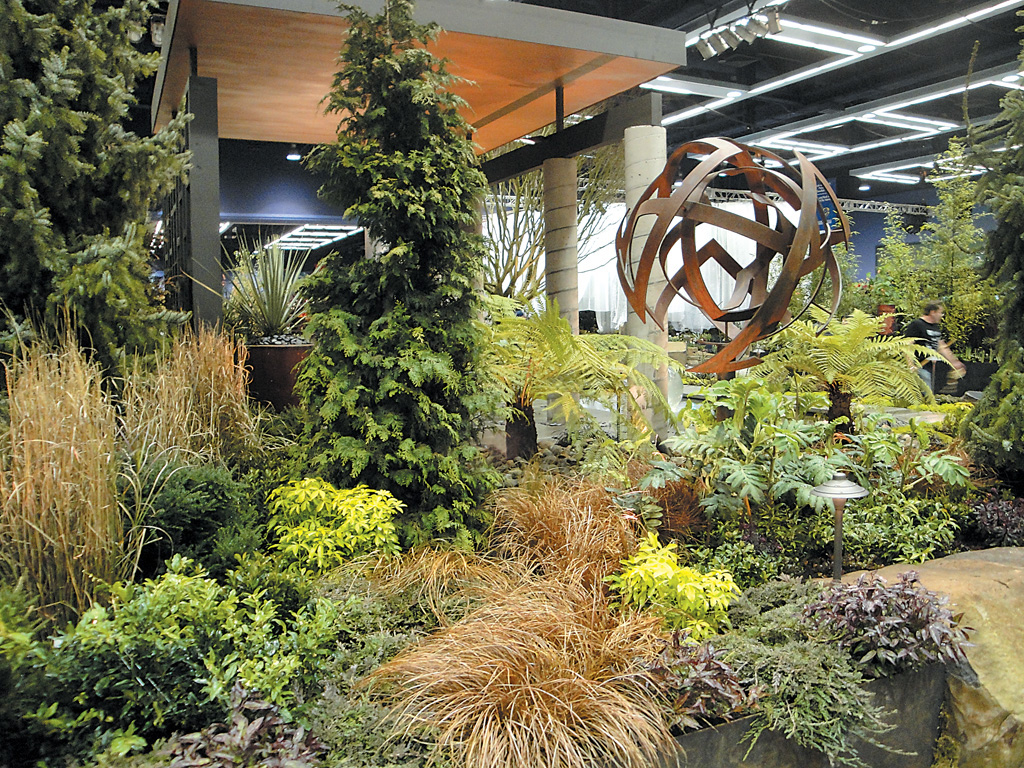
Designers, Plants, Growers
The talent of the designer and the skill of the grower are on full display at both flower shows. Both shows demonstrate remarkable ingenuity as they highlight current trends in design; some displays offer a touch of whimsy to remind visitors that it is, in fact, a show! The rising interest in edible gardening over the years has led to some engaging displays at both shows; small urban gardens are also well represented.
Chelsea has a long-established relationship with growers who have developed the practice of bringing all manner of plants into flower on cue for the show—an easier assignment given the show’s late May date. The NWFGS has the more challenging task of pushing plants into bloom in the middle of winter, which involves expensive greenhouses for forcing everything from spring bulbs to fruit trees to summer perennials. The result is a fairly static palette of plants from year to year. Staples in the NWFGS include sweet box (Sarcoccoca), Lenten and Christmas roses (Helleborus), countless bulbs, rhododendrons, and heaths (Erica), all forced into flower, along with colorful stems of dogwoods and contorted willows, conifers of all sizes, and plenty of primroses. It’s up to the designers to find original ways to incorporate these plants into appealing gardens.
Garden designers receive the majority of press coverage at the NWFGS, but little attention is given to growers. At Chelsea, growers stage exhibits in the marquee that can rival the show gardens for impact, with kaleidoscopic displays of their specialties, such as bulbs, chrysanthemums, sweet peas, grasses, roses, hostas, or insectivorous plants; again, this is much easier to pull off in May than in February. Growers at the NWFGS are usually found in the marketplace selling potted specimens or bare-root stock, all conveniently labeled and packaged for sale. Plant vendors do not participate at Chelsea, with the exception of a few offering bulbs, seeds, and the like during members’ day; a big “sell-off” in the last hours of the show draws an enthusiastic crowd of gardeners clambering for plants used in the garden installations. A successful sell-off at the Seattle show would surely simplify breakdown for the exhibitors, but home gardeners would need to carefully consider which plants could be safely planted outdoors in February.
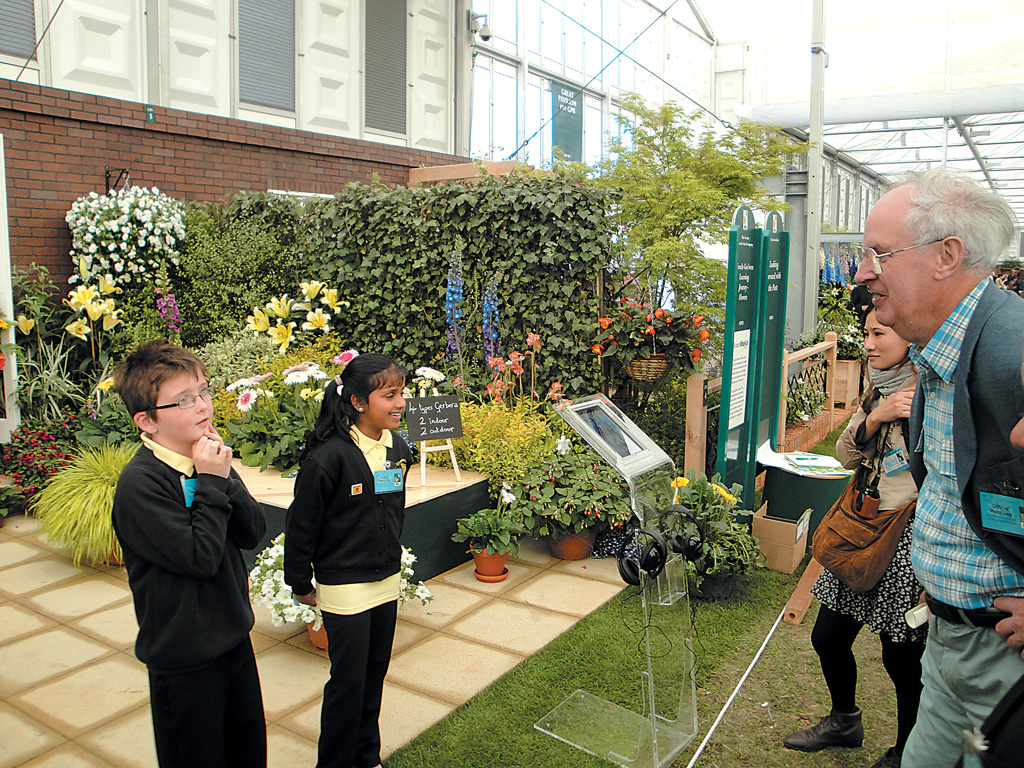
Tomorrow’s Players
One of my missions in London was to gauge the interest of younger individuals in cultivating plants and gardens. I wondered if they would even be present during press day and the first members’ day. To my surprise, there were young exhibitors on the floor talking to the press and making quite an impression. UK horticulture is set with bright young gardeners, growers, and designers anxiously awaiting their moment in the spotlight and a chance at making a Chelsea debut.
A young woman about my age (late twenties) stood in front of a local college’s display, which she had helped design and construct. She expressed a strong interest in landscape design and hoped to be accepted into the school’s highly competitive program. I asked about individual plant specimens and how they were raised to be in bloom for the show; her plant knowledge was exceptional. I also had the pleasure of speaking to two children from a contingent of grade school students who helped design and build an edible courtyard garden. They immediately acknowledged the honor of exhibiting at Chelsea and the great fun they had designing the garden. I asked what their favorite plants were and was surprised by their responses:
“Oh, how could I possibly choose?! I love the leaves and texture of the kale and the espaliered apples when they ripen. Oh! The gerberas! It has to be the gerberas, because they add so much color to the garden.”
I was blown away by the notion of a nine-year-old knowing what gerbera daisies were; the experience warmed my heart.
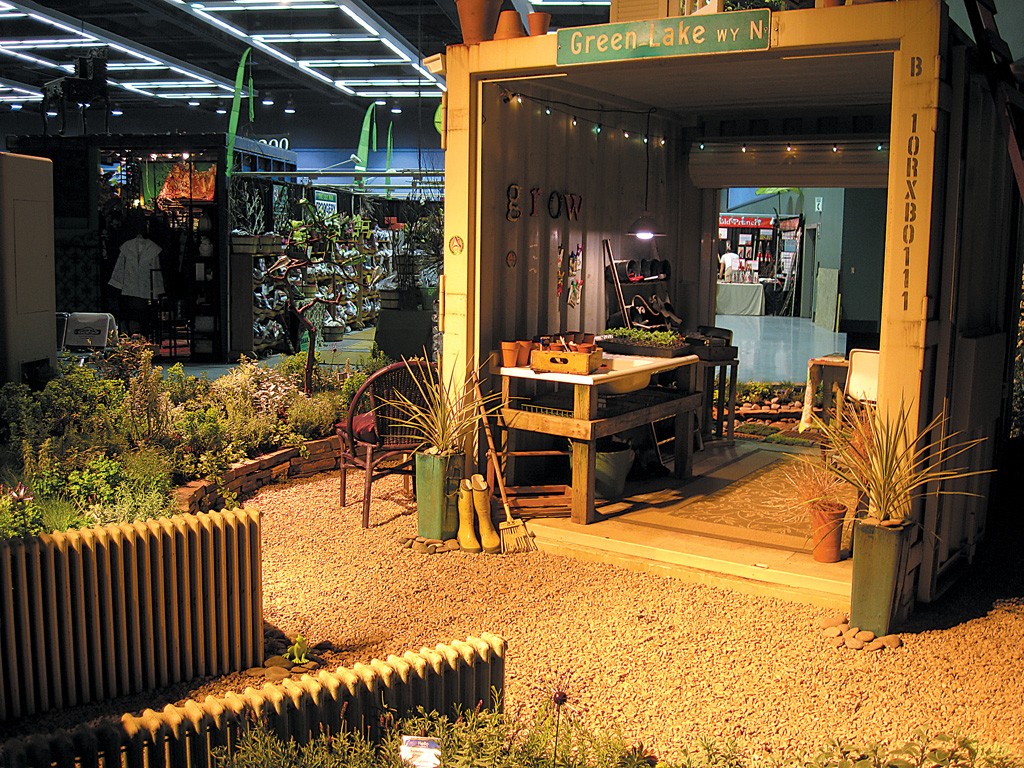
The NWFGS attracts much younger children to a variety of family friendly exhibits and displays that encourage kids to dig in the soil, observe crawling insects, and pull up carrots and radishes from bins of compost. For some, this is their first exposure to gardening. Young designers have also begun to make their mark on the main show floor, with innovative designs utilizing recycled products and more sustainable approaches to garden maintenance. In the 2011 show, seventeen-year-old Courtney Goetz won awards for her garden entitled “Paradise (to be) Regained,” based on an essay by Henry David Thoreau. In her blog, she stated,
“My goal and intent for this garden is to have eco-minded green and fun ideas that anyone could instill in their lives. I want the message to get out that not everyone can afford solar panels or hybrid cars, but anyone can and will make a difference by using a little bit less and utilizing what they already have. My generation is facing the difficult challenge of using less and conserving more, so any little bit from anything helps.”
The impact of these shows on visitors, especially this younger generation, is exceedingly important. While Chelsea and NWFGS have obvious differences in the way they are set up, publicized, and promoted, their missions are the same: to further the art and science of gardening and to ensure that this celebration of horticultural prowess continues to grow and evolve, inspiring not just gardeners, but everyday people who adore plants, flowers, and the natural environment around them.











Responses